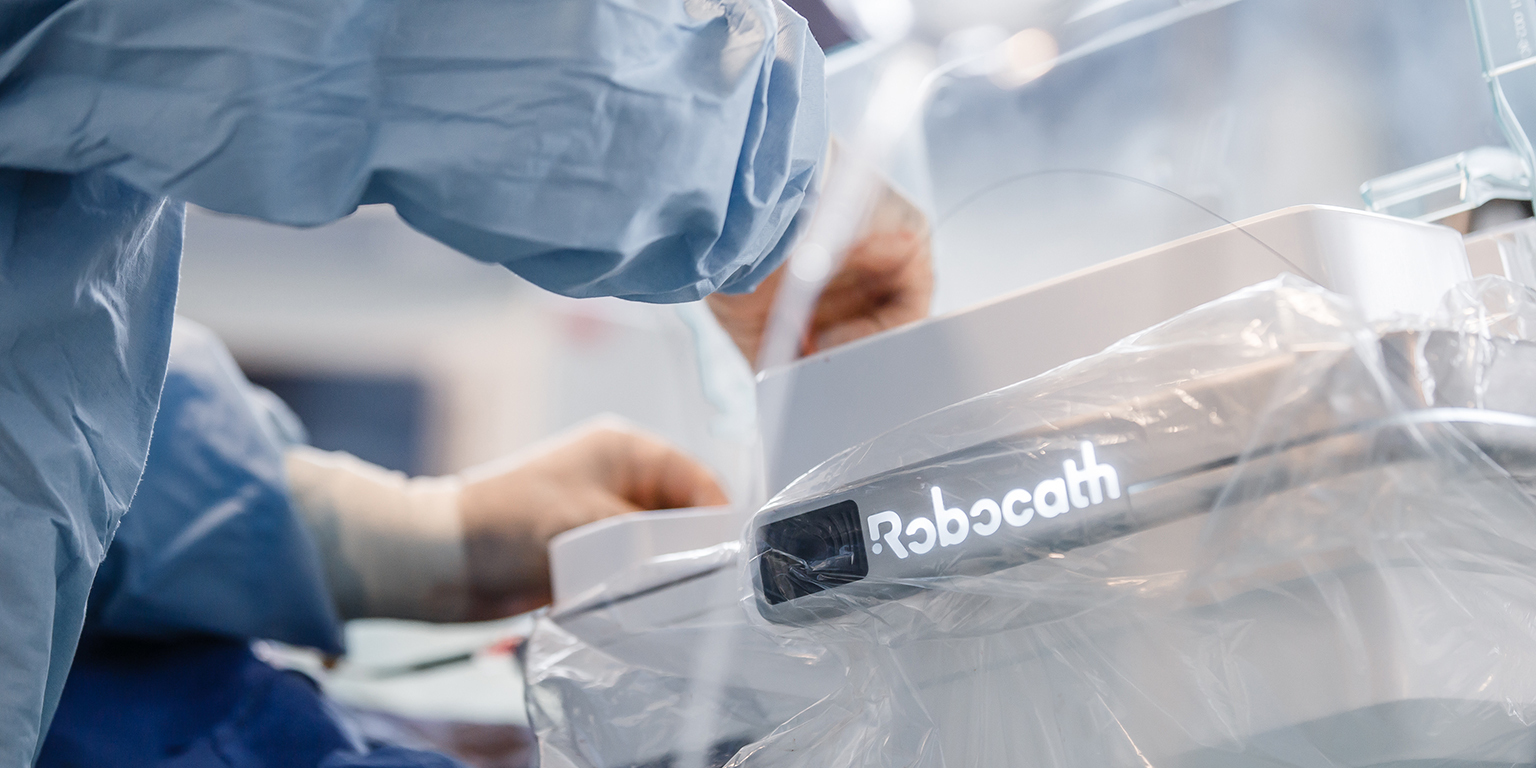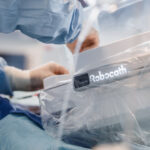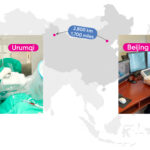Share this post:

- 100% clinical success rate: zero complications linked to robot up to 30 days post-procedure
- >95% technical success rate
- 84.5% average reduction in physician radiation exposure
Rouen, France, May 18, 2022 – Robocath, a company that designs, develops and commercializes innovative robotic platforms for the treatment of vascular diseases, today presents the results of its R-Evolution clinical study at the international EuroPCR conference. The study, which included 62 patients across six European centers, shows that coronary angioplasties using the R-One™ robot are safe and effective for patients, while also improving the working conditions for the interventional cardiologist by drastically reducing exposure to X-rays.
The results will be presented in detail at a second dedicated session ‘Robotic PCI: Evolution or R-Evolution’ on Thursday May 19, in room 251 between 12:15 and 1:00 p.m. (CET).
R-One is a medical robot specifically designed to perform coronary angioplasties (stent implantation). From the comfort of a control station shielded against radiation, the physician uses joysticks to remotely control the devices needed for the procedure, such as guidewires, balloons and stents. R-One was CE-marked in 2019 and is currently used in Europe, Africa and China.
The R-One robotic system provides several benefits to both physicians and patients. First, the physician and medical staff are protected from radiation exposure during the procedure; daily exposure to X-rays by physicians that use manual coronary angioplasty has been linked to harmful effects such as cancer and cataracts. Second, physicians using the R-One robotic system do not need to wear heavy lead protective gear; preventing musculoskeletal conditions caused by the long-term use of such equipment. Third, the navigation and accuracy of balloon and stent placement is improved due to the millimeter precision of the robotic controls and because the devices are locked tightly in position while moving through the vasculature. The features of R-One provide a safer and more ergonomic working environment, while improving precision and accuracy of device placement compared to manual procedures.
The R-Evolution trial was a prospective, non-randomized, single-arm clinical study that assessed the safety and efficacy of the R-One robot when used for coronary angioplasties. A total of 62 patients (64 treated lesions) at six European centers¹ were included in the trial. One quarter of the lesions were classified as complex under the ACC/AHA classification². Final patient enrollment in the study was initially planned for September 2020. However, due to the pandemic, the last patient was enrolled on October 8, 2021.
“This was the first clinical trial in Europe that aimed to assess the safety and efficacy of robotic coronary angioplasty. The results are extremely positive, with a technical success rate of over 95% and a clinical success rate of 100%, all of which show that angioplasties with R-One are safe and effective for patients,” saidProf. Eric Durand, interventional cardiologist and co-principal investigator in the trial, during his presentation of the results this morning. “In my experience, the average length of a robotic procedure (19.9 ± 9.6 min) is roughly the same as that of a manual procedure. Based on these results, the use of the robot genuinely heralds a new age in the treatment of heart conditions, something that has been sorely needed for 30 years given the significant challenges involved in this discipline, particularly the exposure to X-rays.”
R-Evolution trial investigator Prof. Stefan Verheye, interventional cardiologist at ZNA Middelheim hospital in Antwerp, who will be presenting detailed results during a dedicated session on Thursday, May 19, at 12:15 p.m., added: “For the first time in my career I was able to operate while sitting comfortably, without having to wear a lead apron and completely shielded from X-rays. I also benefited from the exceptional visual layout, with the display right next to the radioscopy monitors.”
One of the goals of the trial was to measure X-ray exposure to robotic operators compared with traditional manual operators. This was simulated by placing a pole near the operating table. The average radiation dose received by the robotic operator was 0.2 µSv, which was 300 times lower than the radiation received by the simulated manual operator on the head and other parts of the body not protected by lead gear. On average, performing a coronary angioplasty robotically reduces the physician’s exposure to X-rays by 84.5%. Robotic operators still receive some X-ray exposure while manually placing the first device prior to beginning the robotic portion of the procedure; if the physician has an assistant who places the first device, the radiation dose to the physician is reduced by 100%.
“These working conditions are much safer and more comfortable than operating by hand, which means I can focus all my attention on my technique. The robot also allows me to position a stent with millimeter precision and place it safely, as the system always locks the devices in place. It is easy to learn and intuitive to use. I am delighted to continue assessing the robot routinely in the context of an observatory registry,” explained Prof. Stefan Verheye.
Dr. Jean Fajadet, co-principal investigator on the study, Clinique Pasteur in Toulouse, current vice-chairman at EuroPCR, and session host on Thursday, May 19, added: “Robotic coronary angioplasty marks a watershed moment. It is at this time the only viable and long-term answer to procedures becoming increasingly long and complex, and requiring high precision, expertise and experience in interventional cardiology. While it is revolutionary, the system uses the same devices as those currently used and is compatible with all imaging systems, which should make uptake easy among all physicians.”
President and founder of Robocath, Philippe Bencteux, explained: “The R-Evolutiontrial demonstrates that robotic vascular procedures represent a safe and effective alternative to operating manually, with excellent clinical and technical success rates. They provide better working conditions for the physician and medical staff, which indirectly benefits the patient.”
“The extremely encouraging results from this study and the reports that we have had from initial users confirm that our solution is both suitable and beneficial for patients and doctors alike,” said Lucien Goffart, CEO of Robocath. “Our plan is to continue to demonstrate and quantify these benefits through a highly pro-active clinical program in partnership with centers of excellence such as Rouen University Hospital, ZNA Middelheim in Antwerp, the Neuss Clinic in Germany, and many others. This is an essential step towards better meeting the needs and expectations of our users. We firmly believe that this is just the beginning of vascular robotics and that it will continue to grow with our current, as well as our future, robotic generations, with which the more complex procedures will be performed. Robotics is right at the heart of a sea change within this sector. It will be the main vector for integrating future technological advances by centralizing the whole procedure into one single interface, which will in turn be the starting point for using AI. There is no doubt in my mind that the future of interventional cardiology lies in integrating robotics.”
Robocath at EuroPCR 2022
Attendees at EuroPCR 2022 have the opportunity to:
- Witness a demonstration of the robot and test out the system at Robocath’s booth (M19) on the second floor
- Attend Robocath’s session ‘Robotic PCI: evolution or R-Evolution’ on May 19, from 12:15 to 1:00 p.m. in room 251, hosted by Dr. Jean Fajadet and Prof. M. Haude.
A detailed presentation of R-Evolution’s results will be given by Prof. Stefan Verheye, and a demonstration of a recorded case study using R-One carried out at Brest University Hospital will be presented by Prof. Martine Gilard in partnership with GE Healthcare
About Robocath
Founded in 2009 by Philippe Bencteux, MD, Robocath designs, develops and commercializes robotic solutions to treat cardiovascular diseases. As an active player in the evolving medical robotics industry, these innovative solutions aim to make medical procedures safer, while complementing manual interventions.
R-One™ is the first solution developed by Robocath. It uses a unique bionic technology that optimizes the safety of robotic-assisted coronary angioplasty. This medical procedure consists of revascularizing the cardiac muscle by inserting one or more implants (stents) into the arteries that supply it with blood. Every 30 seconds, somewhere in the world, this type of procedure is performed. R-One is designed to operate with precision and perform accurate movements, creating better interventional conditions. Thanks to its open architecture, R-One is compatible with market-leading devices and catheter labs.
R-One received the CE marking in 2019. In a prospective, multicenter, non-randomized, single-arm clinical trial, R-One demonstrated safety and efficacy as it achieved more than 95% technical procedure success with no MACE (major adverse cardiovascular events). Currently R-One is available in Europe, Africa and China.
Robocath aims to become the world leader in vascular robotics and develop remote treatment of vascular emergencies, guaranteeing the best care for all. Based in Rouen, France, Robocath has more than 70 employees.
www.robocath.com
¹ Rouen and Caen University Hospitals in France (Prof. Durand and Prof. Sabatier), Clinique Pasteur in Toulouse, France (Dr. Fajadet), ZNA Middelheim hospital in Antwerp, Belgium (Prof. Verheye), Maasstad hospital in Rotterdam, Netherlands (Prof. Smits and Dr. Van Der Ent), and the INCCI (National Institute for Cardiac and Interventional Surgery) in Luxembourg (Dr. Pereira and Dr. Muller)
² American College of Cardiology (ACC) / American Heart Association (AHA)
To download documents, you can right-click on the links above and chose « Save link as… »




